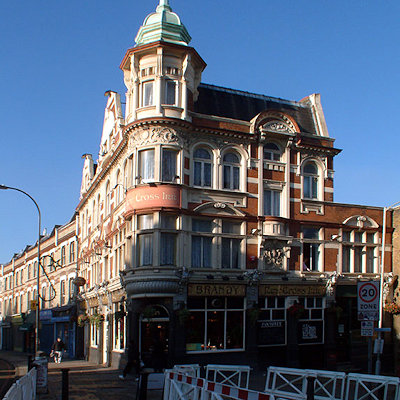
Like us on Facebook
PLACE NAMES


 
|
|
New Cross
|

|
|
 | Pepys House, 2 Cutty Sark Gardens, Greenwich - 0870 608 2000
St. Paul's Churchyard, London - 020 7332 3456
tic@visitgreenwich.org.uk
|
New Cross is a district and ward of south London in the London Borough of Lewisham, England. It is situated 4.5 miles south-east of Charing Cross. The ward covered by London post town and the SE 14 postcode district. New Cross is near St Johns, Telegraph Hill, Nunhead, Peckham, Brockley, Deptford and Greenwich. New Cross is home to Goldsmiths, University of London, Haberdashers' Aske's Hatcham College and Addey and Stanhope School.
New Cross Gate, on the west of New Cross, is named after the New Cross tollgate, established in 1718 by the New Cross Turnpike Trust. It is the location of New Cross Gate station. New Cross Gate corresponds to the manor and district formerly known as Hatcham.
The area was originally known as Hatcham (the name persists in the title of the Anglican parishes of St. James, Hatcham along with its school, and All Saints, Hatcham Park). The earliest reference to Hatcham is the Domesday Book of 1086 as Hacheham. It was held by the Bishop of Lisieux from the Bishop of Bayeux. According to the entry in the Domesday Book Hatcham's assets were: 3 hides; 3 ploughs, 6 acres of meadow, woodland worth 3 hog.
Hatcham tithes were paid to Bermondsey Abbey from 1173 until the dissolution of the monasteries. A series of individuals then held land locally before the manor was bought in the 17th century by the Haberdashers' Company, a wealthy livery company that was instrumental in the area's development in the 19th century. Telegraph Hill was for many years covered by market gardens also owned by the Worshipful Company of Haberdashers. Until the creation of the London County Council in 1889, the area was a part of the counties of Kent and Surrey.
New Cross is believed to have taken its name from a coaching house originally known as the Golden Cross, which stood close to the current New Cross House pub. The diarist John Evelyn, who lived in Deptford, wrote in 1675 that he met a friend at 'New Crosse' in his coach before travelling down through Kent and on to France.
In the later 19th century, the area became known as the New Cross Tangle on account of its numerous railway lines, workshops and two stations - both originally called New Cross (one was later renamed New Cross Gate).
Hatcham Iron Works in Pomeroy Street was an important steam locomotive factory, the scene of a bitter confrontation in 1865 between its manager, George England, and the workers. The Strike Committee met at the Crown and Anchor pub in New Cross Road, now the site of Hong Kong City Chinese restaurant. George England's house, Hatcham Lodge, is now 56 Kender Street.
New Cross bus garage was formerly the largest tram depot in London, opening in 1906. During the 1926 General Strike in support of the miners, strikebreakers were brought in to drive trams from the depot. On 7 May, police baton charges were launched to clear a crowd of 2-3,000 pickets blockading the entrance (reported as "Rowdyism in New Cross" by the Kentish Mercury).
The last London tram, in July 1952, ran from Woolwich to New Cross. It was driven through enormous crowds, finally arriving at its destination in the early hours of 6 July.
|
 Feel free to Email me any additions or corrections Feel free to Email me any additions or corrections
LINKS AVAILABLE TO YOUR SITE
| |





